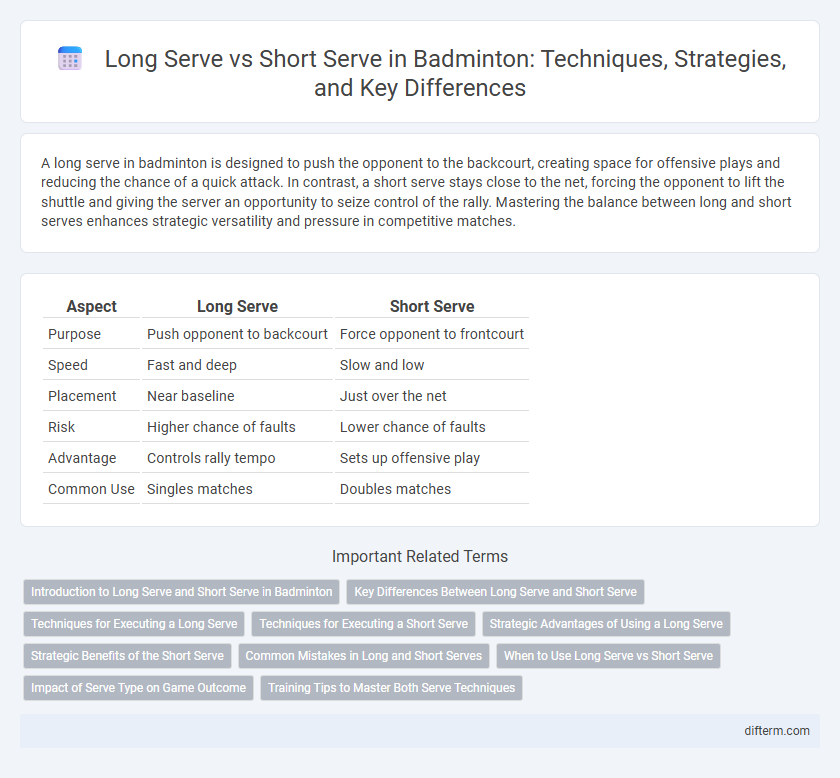A long serve in badminton is designed to push the opponent to the backcourt, creating space for offensive plays and reducing the chance of a quick attack. In contrast, a short serve stays close to the net, forcing the opponent to lift the shuttle and giving the server an opportunity to seize control of the rally. Mastering the balance between long and short serves enhances strategic versatility and pressure in competitive matches.
Table of Comparison
| Aspect | Long Serve | Short Serve |
|---|---|---|
| Purpose | Push opponent to backcourt | Force opponent to frontcourt |
| Speed | Fast and deep | Slow and low |
| Placement | Near baseline | Just over the net |
| Risk | Higher chance of faults | Lower chance of faults |
| Advantage | Controls rally tempo | Sets up offensive play |
| Common Use | Singles matches | Doubles matches |
Introduction to Long Serve and Short Serve in Badminton
Long serves in badminton involve hitting the shuttlecock deep into the opponent's backcourt, aiming to push them away from the net and create opportunities for attacking shots. Short serves are executed close to the net, designed to keep the shuttle low and prevent aggressive smashes from the opponent. Mastering both serves is crucial for controlling the pace and strategy in badminton matches.
Key Differences Between Long Serve and Short Serve
Long serves in badminton aim to push the opponent to the backcourt, maximizing court coverage and creating attacking opportunities, while short serves target the frontcourt, intended to force weak net returns and quick net engagements. Long serves typically generate higher shuttle speed and more distance, contrasting with short serves that emphasize precision and control over shuttle placement. The strategic choice between long serve and short serve significantly affects rally dynamics, player positioning, and point construction in competitive badminton.
Techniques for Executing a Long Serve
Effective long serves in badminton require precise racket angle control, striking the shuttlecock with an extended arm and a smooth, controlled swing to generate sufficient power and height. Players must focus on tapping the shuttle below the waist, ensuring the serve travels deep into the opponent's court to limit offensive returns. Consistent practice of wrist snap and follow-through mechanics enhances accuracy and the ability to disguise the serve.
Techniques for Executing a Short Serve
Executing a short serve in badminton requires a precise grip and controlled wrist movement to deliver the shuttle just over the net. The technique involves a low racket angle and a gentle but firm push, ensuring the shuttle lands close to the opponent's service line. Mastery of body positioning and timing enhances accuracy and limits the opponent's attacking options.
Strategic Advantages of Using a Long Serve
A long serve in badminton pushes the opponent to the backcourt, creating opportunities to control the net and launch offensive plays. By forcing the receiver into a defensive stance, it disrupts their rhythm and limits their attacking options. This strategic placement increases the likelihood of forcing weak returns, setting up aggressive smashes or drop shots.
Strategic Benefits of the Short Serve
The short serve in badminton enables players to maintain a low trajectory close to the net, limiting the opponent's attack options and forcing weak returns. This strategic shot disrupts the opponent's rhythm by preventing aggressive smashes, making it ideal for controlling the pace in doubles matches. Employing short serves also increases the chances of winning the rally early by capitalizing on tight net play and exploiting opponents' positioning.
Common Mistakes in Long and Short Serves
Common mistakes in long serves include overhitting, causing the shuttle to fly out of bounds, and inconsistent shuttle height, which reduces accuracy and gives the opponent an advantage. In short serves, errors often involve serving too high, allowing opponents to attack aggressively, or failing to keep the shuttle close to the net, resulting in an easy return. Mastering the precise shuttle trajectory and placement is crucial for both serves to maintain strategic advantage in badminton.
When to Use Long Serve vs Short Serve
Use a long serve in badminton during singles play to push your opponent to the backcourt, creating space for attacking shots and maintaining rally control. Employ a short serve in doubles to prevent your opponents from executing powerful smashes and maintain a low trajectory that challenges their net play. Choosing between long and short serves depends on your strategic position, opponent's weaknesses, and game format to maximize point-winning opportunities.
Impact of Serve Type on Game Outcome
The type of serve in badminton significantly influences game outcomes by dictating the pace and positioning from the start of each rally. Long serves push opponents to the backcourt, creating opportunities for aggressive smashes, whereas short serves emphasize net play and quick reflexes, often leading to fast exchanges. Strategic selection between long and short serves can disrupt an opponent's rhythm, increasing the serving player's chances of controlling the game tempo and securing points.
Training Tips to Master Both Serve Techniques
Mastering both long and short serve techniques in badminton requires focused training on precision and control; practicing targeted drills that emphasize shuttle placement and varying racket angles enhances serve accuracy. Incorporating footwork exercises improves positioning, enabling smoother transition between long and short serves during gameplay. Regular video analysis of serve mechanics combined with consistent repetition builds muscle memory, ensuring adaptability and effectiveness in match situations.
long serve vs short serve (badminton) Infographic

 difterm.com
difterm.com